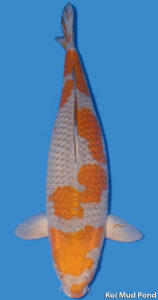Ochibashigure - "Ochiba"
Ochibashigure (O-chee-ba-shee-gore-ay) called Ochiba (o-chi-ba) for short, means ‘leaves of Fall on the water” This is because of the original improved breed look of a base blue-gray fish (the water) with a brown pattern on its back (the dead leaves of fall). Ochiba also come in a Doitsu version, that should have all the characteristics of the Wagoi (fully scaled) version, minus the reticulation of the wagoi. The very first Ochiba were developed from crossing Chagoi (all brown fish) and Soragoi (solid blue-gray ) Since the original ones however, the base color has been expanded to the improved blue, or orangy, and even yellowish. Today it seems most people still prefer the blue-gray based fish. They can come in Doitsu (scale less or partially scaled) or Wagoi (fully scaled) versions.
So an Ochiba has a base color of blue-gray most often, but can be the other base colors mentioned previously. On top of the base color is the pattern like that of a Kohaku, that can come in steps preferably, but can also be one large plate on the back as well. This pattern is usually and orange or brownish color. The base color of the fish has a reticulation look to it like that of fine netting. This is caused by each scale being traced in a very thin line which defines the shape of each scale and make it stand out. This breed is known to be docile and friendly and can grow to large sizes as well.
A Good Ochiba
Basically, a good Ochiba should have all the characteristics of a good Kohaku. You want the base color to be consistent with good scale reticulation. No scales should be misaligned. You want a good contrast between the base color and the patterned plate of the other colors on the back. This pattern should be pleasing to the eye, and more importantly balanced looking. Multiple steps in the pattern are also preferred. You want a strong kiwa (pattern edges) on each plate of the pattern. You do not want smeared or fading edges here, as this is a sign that the pattern will fade or even disappear all together. A good body confirmation is also very important, and the fish should generally have a robust, and solid look to it. it should in general terms look powerful.
Written by John Fornaro, Hanover Koi Farms. ALL RIGHTS RESERVED BY HANOVER KOI FARMS, COPYRIGHT © 2017
